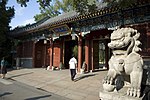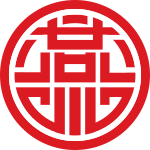Beijing 101 Middle School

Beijing 101 Middle School (北京一零一中学) is a public secondary school in Haidian, Beijing, China. It offers programs from grades 7 to 12. The early predecessor of Beijing 101 Middle School was established in Zhangjiakou in 1946. The school's name was successively changed to Zhangjiakou Municipal Middle School, Shanxi-Chahar-Hebei Border Area United Middle School, North China Yucai Middle School, and the Second Department of the Middle School Affiliated to Beijing Normal University. In 1955, the school was named Beijing 101 Middle School.In addition to the main campus, the school has seven branch campuses: Shuangyushu, Shangdi, Huairou, Wenquan, Shiyou, Kuangda, and Daxing.
Excerpt from the Wikipedia article Beijing 101 Middle School (License: CC BY-SA 3.0, Authors, Images).Beijing 101 Middle School
Qinghua West Road, Haidian District Yanyuan
Geographical coordinates (GPS) Address Nearby Places Show on map
Geographical coordinates (GPS)
| Latitude | Longitude |
|---|---|
| N 40.0021 ° | E 116.3004 ° |
Address
北京第一〇一中学
Qinghua West Road
100091 Haidian District, Yanyuan
Beijing, China
Open on Google Maps








